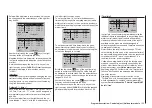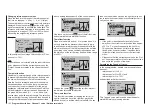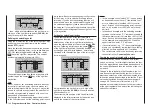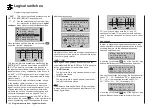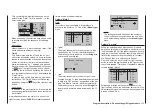
138 Program description - Channel 1 curve | Winged models
Channel 1 curve
Control characteristics for throttle/spoiler stick
This option is available as standard on
both transmitter types.
Use the selection keys of the left or right
four-way button to scroll to the »Channel
1 curve« menu option in the Multi-function menu:
Servo adjustment
Stick mode
Switch display
Control adjust
Dual Rate / Expo
Channel 1 curve
Open this menu option with a tap on the center
SET
key of the right four-way button:
Input
Output
Point ?
0%
0%
0%
Ch1 curve
Curve off
Since the carburetor response or the effect of the air-
brakes or spoilers is often non-linear, you can make
compensatory adjustments to these in this menu.
The menu therefore enables you to change the
control characteristics of the throttle / airbrake stick,
regardless of whether this control function affects the
servo connected to control channel 1 directly or af-
fects multiple servos via various mixers.
If flight phases have been specified in the »Phase
settings« and »Phase assignment« menus (see
pages 152 and 158) this option can be adapted
on a flight-phase basis. The given flight phase name,
e. g. «normal», will be shown at the bottom left of
the screen.
The control curve can be defined by up to 6 points
(termed “reference points” below) placed anywhere
along the path of stick travel. While the on-screen
graph considerably simplifies the process of setting
and adjusting the reference points, we recommend
that you set fewer reference points to begin with.
In the basic software set-up, 2 reference
points – namely the end-points at the bottom end of
stick travel (“L”, low = -100 % travel) and the top end
of stick travel (“H”, high = +100 % travel) – define a
linear characteristic curve.
First, switch to your chosen flight phase, if necessary.
Setting reference points
By moving the transmitter control (throttle/airbrake
stick), you can reposition the vertical line in the graph
between the two end-points “L” and “H”.
The current stick position is also displayed in numeri-
cal form on the “Input” line (-100 % to +100 %). The
point at which this line crosses the curve is termed
the “Output”, and can be varied at the reference
points within the range -125 % to +125 %. The control
signal altered in this way will then affect all subse-
quent mixer and coupling functions.
In the example above, the stick is at 0 % of control
travel and also generates an output signal of 0 %,
since the characteristic curve is linear.
Up to 4 additional reference points can be set be-
tween the two end-points “L” and “H”, although the
distance between neighboring reference points must
not be less than approx. 25 %.
If necessary, use the left or right-hand arrow button
to move the marker frame down to the “Point” line:
Input
Output
Point ?
0%
0%
0%
Ch1 curve
normal
Curve off
Move the stick. If a question mark can be seen in the
“Point” frame, then the next reference point can be set
with a tap on the center
SET
key of the right four-way
button. Simultaneously, the “?” is replaced by a num-
ber and the value field to the right of the reference
point number will be shown in inverse video.
1
+50%
+50%
+50%
normal
off
Input
Output
Point
Ch1 curve
Curve
The order in which you generate the (maximum) 4
reference points between the end-points “L” and “H” is
irrelevant, since the reference points are continuously
renumbered automatically from left to right as they
are entered.
Erasing reference points
To delete one of the reference points (1 to max. 4),
use the stick to move the vertical line into the vici nity
of the reference point in question. As soon as the
reference point number and the associated value are
superimposed in the “Point” line, you can activate the
Value field by pressing the central
SET
button of the
right-hand four-way button, then erase it by simulta-
neously pressing the
or
buttons of the right-
hand four-way button (CLEAR). A brief press of the
central
ESC
button of the left-hand four-way button
concludes the procedure.
Changing reference point values
Move the stick into the range of the reference point
that is to be changed: “L” (low), 1 … 4 or “H” (high).
The number and current curve value of this point are
displayed. Press the central
SET
button of the right-
hand four-way button to activate the Value field. The
reference point value displayed in inverse video can
be changed in a range of -125 % to +125 % without
influencing the neighboring reference points.
mc
16 20
Содержание HoTT MC-16 Series
Страница 1: ...Programming Manual mc 16 mc 20 HoTT 1 en mc 16 mc 20...
Страница 27: ...27 For your notes...
Страница 53: ...53 For your notes...
Страница 61: ...61 For your notes...
Страница 65: ...65 For your notes...
Страница 71: ...71 For your notes...
Страница 103: ...103 For your notes...
Страница 107: ...107 For your notes...
Страница 111: ...111 For your notes...
Страница 133: ...133 Program description Dual Rate Expo Winged models Set the Expo values as necessary in the same man ner...
Страница 137: ...137 Program description Dual Rate Expo Helicopter models Set the Expo values as necessary in the same man ner...
Страница 155: ...155 For your notes...
Страница 165: ...165 For your notes...
Страница 201: ...201 For your notes...
Страница 229: ...229 For your notes...
Страница 231: ...231 For your notes...
Страница 261: ...261 For your notes...
Страница 265: ...265 For your notes...
Страница 301: ...301 For your notes...
Страница 327: ...327 For your notes...
Страница 328: ...328 For your notes...


